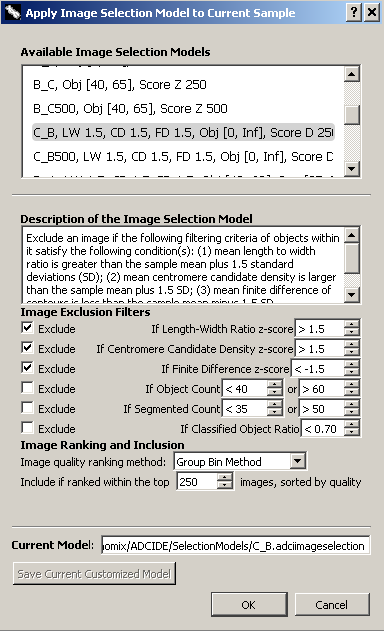This is an old revision of the document!
Table of Contents
Image selection model
An image selection model is a series of filters which exclude undesirable images within a sample from use in calibration curve generation or dose estimation. Excluded images are still present in the sample and can be viewed in the metaphaseimgviewer within which they can be manually re-included.
Apply an image selection model
Image selection models can be applied to a sample in three ways:
- Calibration curve wizard
In the calibration curve wizard, an image selection model may be chosen. If a model is chosen, it will be applied to all samples selected in the wizard when “Finish” is pressed. - Dose estimation wizard
In the dose estimation wizard, an image selection model may be chosen. If a model is chosen, it will be applied to all appropriate samples selected in the wizard when “Finish” is pressed.
Note when an image selection model is applied within either wizard, all images in each selected sample will first be included (meaning there will be no excluded images from previously applied models) before the chosen model is applied.
- Within the metaphase image viewer
Image selection models can be applied within the metaphaseimgviewer. Consult the metaphase image viewer page for more details on how to apply existing image models or create your own there. Please note, the above notice regarding wizards and how they apply image selection models applied for all previously applied image selection models.
Image selection models always only exclude images. They do not re-include images excluded by a previously applied image selection model or by manual exclusion except when automatically applied by a wizard (as described above). If this is not the desired behaviour and you would like to apply the image selection model to a “clean” sample with no images excluded, click the “Include All” button before loading the new image selection model.
Contents of an image selection model
The dialog found to the right can be found in the metaphase image viewer. It is used here to show what properties can be modified in an image selection model. When viewing a list of image selection models within wizards and elsewhere, model property values are shown after the model name using an abbreviation for each property. These abbreviations are listed below, within the header for each property. Properties of the model are as follows:
- Description
A description of the image selection model. This description will appear when selecting image selection models in the calibration curve wizard and dose estimation wizard. - LW - Exclude if length-width ratio z-score is > [value]
Length-width ratio is the average length-width ratio of all chromosomes in an image. This filter excludes images with excessively long or thin chromosomes in a sample. - CD - Exclude if centromere candidate density z-score is > [value]
Represents average level of “noise” in chromosome contours. This filter excludes images with severely “noisy” chromosome contours in a sample. - FD - Exclude if finite difference z-score is < [value]
Represents the average concavity level of chromosomes in an image. This filter excludes images with chromosomes showing insufficient centromere constriction in a sample. - Obj - Exclude if object count is < [value] or > [value]
The number of total objects found in an image, excluding noises and nuclei. Ideally, it would be 46. This filter excludes images with too few or too many chromosomes. - Seg - Exclude if segmented count < [value] or > [value]
The number of objects processed by GVF algorithm in an image. Segmented objects (processed by GVF) are subset of total objects. Ideally, it would also be 46. This filter is similar to object count filter, but more stringent. - Ratio - Exclude if classified object ratio > [value]
The ratio of objects recognized as chromosomes and segmented objects. Classified objects (recognized as chromosomes) are subset of segmented objects. This filter excludes images in which chromosomes are not recognized effectively. - Score - Image ranking and inclusion method
We recommend the minimum number of images remaining after image selection to be greater than 200-250 images.1)- None: ADCI uses no image ranking and inclusion.
- Group Bin Method: ADCI uses group bin method to score images and selects a user-specified number of top-ranked images. This method compares chromosome area pattern in an image with standard base-pair pattern. More information about this method can be found on the group bin method page.
- Combined Filter Score Method: ADCI uses combined filters to score images and selects a user-specified number of top-ranked images. This method combines features of filters as a weighted sum. Users specify a method to calculate weights (IQR or MAD) or fill custom weights.

